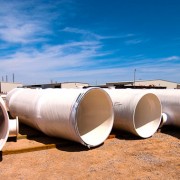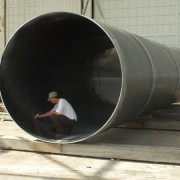FRP Mining Solutions Solve Corrosion Problems
 Many industries report major problems with corrosion each year. It’s a serious problem that can impact production and safety. According to the World Corrosion Organization, the estimated cost of corrosion damage worldwide is 2.2 trillion dollars which is roughly 3%-4% of GDP of industrialized nations.
Many industries report major problems with corrosion each year. It’s a serious problem that can impact production and safety. According to the World Corrosion Organization, the estimated cost of corrosion damage worldwide is 2.2 trillion dollars which is roughly 3%-4% of GDP of industrialized nations.
The mining, mineral processing and extractive metallurgy industries posses the ingredients for an extremely corrosive environment—water, grinding media, dissimilar materials, oxygen, wide pH ranges, and the presence of many microorganisms that promote conditions for corrosion. According to one corrosion study released by CC Technologies Laboratories, Inc., (Dublin, OH), it was estimated that an average of $93 million dollars was spent annually (1998 estimate) on maintenance painting of metal surfaces, to control corrosion in the coal mining industry.
Corrosion can result from a wide range of conditions and thus can be characterized many different ways. For example, corrosion in the mining industry is often characterized as corrosion enhanced by abrasion—this is especially true for pipe and pumping systems used in many mining milling processes. It’s also important to note, the wide range of conditions that can cause corrosion, and because mine atmospheres and waters are unique and vary from one location to the next, make each corrosion related problem difficult to plan for. This particular type of challenge makes material selection a critical component of most corrosion management strategies.
According to that same study released by CC Technologies Laboratories Inc., which interviewed many engineers and mining professionals, material selection is the most important general form of corrosion prevention. It has been demonstrated many times over that choosing the correct material based on the environment decreases the amount of corrosion and lengthens the life span of the equipment.
FRP abrasion and corrosion resistant pipe provide a cost effective material alternative to traditional metal alloys. FRP will not succumb to particulate abrasion or erosion and are often selected for their long life cycles and low maintenance costs. Conversely, with traditional metal piping and pump systems the particulate erodes and removes the protective film of the metal and exposes the reactive alloy to high flow velocity, thus accelerating the corrosion mechanisms.
One corrosion related issue in the mining industry is that it limits the life span of the processing equipment. Specific areas of major concern due to personal safety and continuation of production include: wire rope, roof bolts, pump and piping systems, mining electronics, and acid mine drainage. Similarly, acid mine drainage can cause corrosion problems with pipes, well screens, damns, bridges, water intakes and pumps.
Although protective coatings, corrosion inhibitors, and electrochemical techniques such as cathodic protection are valuable and useful ways to deal with corrosion—they are a short term fix. For example, a 2-coat alkyd/no blasting (4 mil) coating on a metal surface may need touch-up yearly and replacement every two years. Similarly, a 3-coat epoxy/with blasting (10 mil) will need touch-ups every 4 years and replacement after 8 years. On the other hand, FRP have a well documented service life of 35+ years (in some cases more) in harsh corrosive environments throughout the world in mining and minerals, chemical processing, power generation, wastewater, desalination, and pulp and paper.
While FRP does not solve every material problem for every industry, it cannot be denied that it is a cost-effective material that performs exceptionally well in extremely harsh environments, including mining sites. FRP offers design flexibility with constructability.
FRP can be formulated to be abrasion and corrosion resistant. It has a high strength-to-weight ratio, dimensional stability, and offers superior durability—among much else. Whether you are searching for a new design, material upgrade, or custom components that will interface with existing infrastructure or layout—FRP offer a multitude of benefits for many applications.














